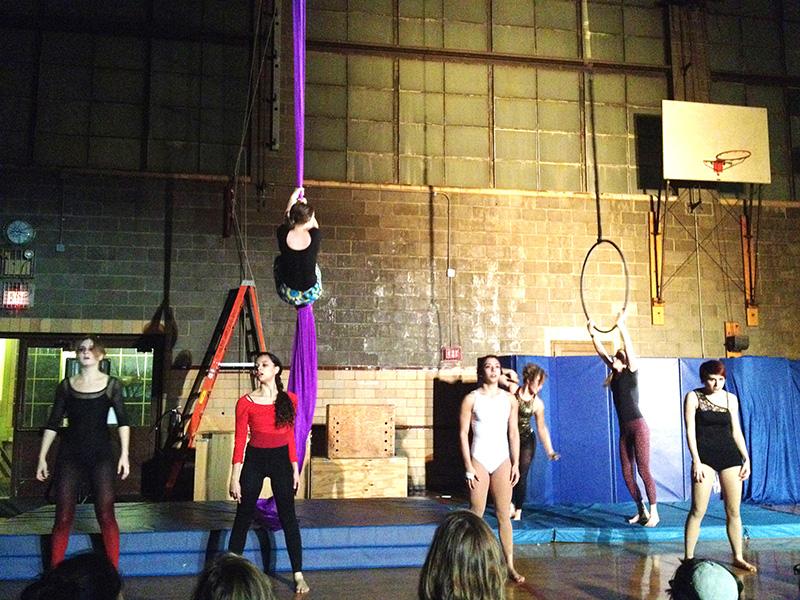In Pandora’s Box, Aerialists Personify Assortment of Evils
November 21, 2014
The audience gasped as College first-year Anika Lindsey suspended herself by her head using swirling purple silks. The silks encircled the back of her head, her outstretched arms creating tension on the silks, while her feet dangled far above the blue mats on the floor. Such startling and astounding feats were presented in the OC Aerialists’ one-night performance of Pandora’s Box in Hales Gymnasium on Saturday.
The performance was based on the Greek myth of Pandora’s box first printed in Hesiod’s “Works and Days.” In this narrative, Pandora, the first human woman, is endowed with gifts from gods and goddesses, including the gift of curiosity. Pandora marries Epimetheus, who represents human men, and Zeus gives Pandora a jar with specific instructions not to open it. But curious Pandora defies Zeus and opens the jar, unleashing evils on humanity. However, hope still remains inside the jar after Pandora closes it.
While by modern standards Hesiod’s myth objectifies Pandora as a “gift” presented to Epimetheus, and modern retellings of the myth describe women as the catalyst for “a plague upon men,” the OC Aerialists’ reinterpretation of the myth celebrated the strength of women. In the opening act, Pandora, played by College junior Maya Muenzer, opened Pandora’s box, which was formed by vertical blue mats, and “evils” dressed in black and red leotards and tights came spinning out. Muenzer went on to perform a graceful solo utilizing a hanging hoop.
In the following acts aerialists personified specific evils. While one might expect an interpretation of violence to be loud, fast paced and chaotic, College senior Vel Nipson’s performance was melancholic and elegant. Swinging from her legs upside down on the trapeze, she performed to “Bang Bang (My Baby Shot Me Down),” first released as a single by singer-actress Cher. The slow, powerful music and its lyrics complemented Nipson’s movements, which oscillated from dangling from the trapeze to standing tall on top of the trapeze bar, suggesting an internal struggle to find a sense of calm. Her emotional act gave a quiet and tragic beauty to a performance that could have been melodramatic.
College sophomore Kat Geber, who portrayed “madness,” began her performance by sitting on the mat with her head in her hands.
The anxiety in her jerky movements increased as she hung from the silks by her ankle, waving her arms around her head. Another impressive point of the piece was when Geber went into the splits in midair, suspended by silks wrapped around each of her ankles, the strain in her body a physical representation of the psychological stress symbolized by her performance. The piece ended dramatically with Geber hanging upside-down with her hair just brushing the floor.
College sophomore Zoe Beach’s interpretation of addiction resonated with both Nipson and Geber’s performances, all of which skillfully showcased beauty, despite the fact that they portrayed ugly human behaviors. Deftly twisting her body, she performed to Jhené Aiko’s “3:16 AM,” which references both addiction to drugs and to lovers and includes lyrics appropriate for the aerial performance, such as “I do not feel the fear of falling / Thought I could fly.” The impressive repeating somersaults Beach did around the trapeze’s bar fittingly mirrored the cyclical nature of addiction. Like Nipson and Geber’s performances, Beach’s movements were strong and controlled, as well as daring and expressive.
The cohesive theme of Pandora’s box celebrated the female body as a medium for creativity. The performers’ physical strength allowed them to achieve graceful and elegant artistic expression. The performance of the final act, “Hope,” exemplified both these aspects of the show. Dancers on the floor raised their bent-over bodies in wakeful circular motions while Beach and Geber performed a complicated, cooperative duo on the trapeze. The symmetry in their movements and the necessary supportiveness needed to pull off feats like hanging upside-down from one another’s arms off of a trapeze emphasized the importance of working together to achieve a hopeful future.


























